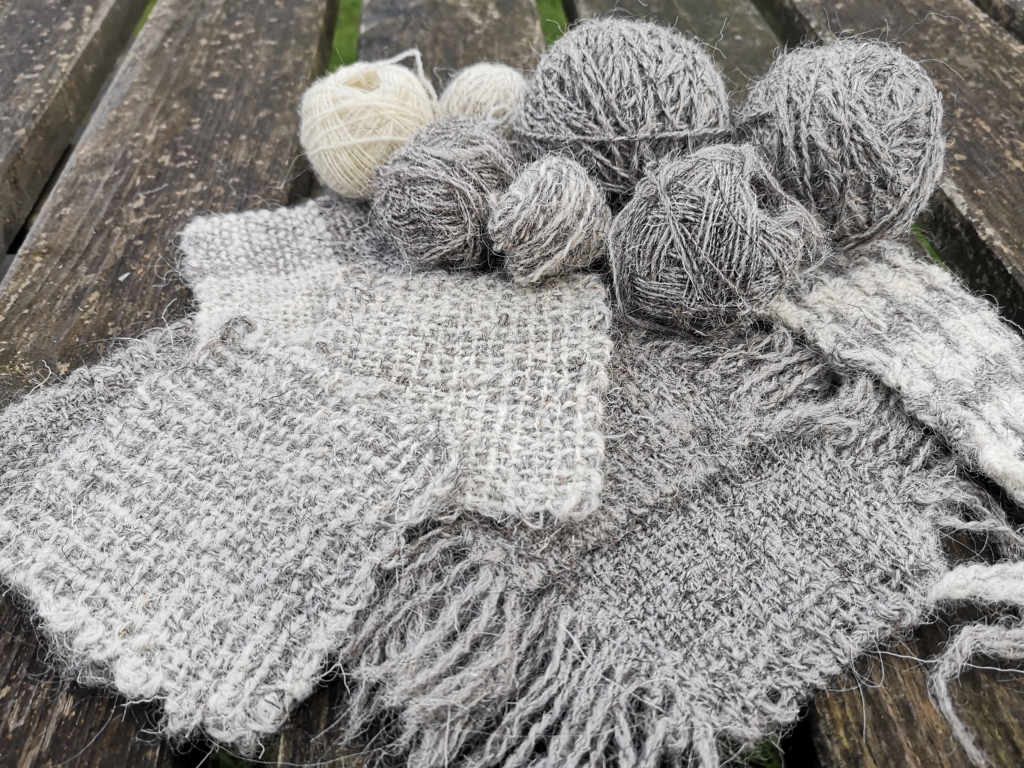Herdwick and Swaledale Yarn; local yarn for local cloth. Actually this isn’t local yarn to me, but it’s locally distinctive yarn. It’s shorn from sheep able to weather windy hilltops and cold winters of northern England. With their slightly kempy (hairy) woolly coat, they produce a durable, hardy yarn that’s more likely to make it into a good tweed or blanket, rather than a snuggly knit scarf. It’s wool with character – just like the sheep.
There’s something to be said for durable, springy, extra warm wool. As it makes good tweed, I’ve got my weaving needle out. As you can see, I’m not a weaver with finesse, as I’m more of a knitter and crocheter. I’d like, eventually though, to weave some tweed befitting of cold, bleak winter landscapes. It’s no wonder that I’d not look out of place striding across the Lake District fells or across the Yorkshire Dales and North Yorkshire Moors wearing this cloth.
For now, I’m just hand spinning yarn and weaving samples on a vintage Weave It loom and a homemade picture frame loom. Call it fibre research.
Landscape, Fleece and Wool
Fleece on the backs of Herdwick and Swaledale sheep is not all kemp (hair). They have warm, downy wool too, that I’m sure has developed over the ages as a protection against cold. As I said in my last post (What’s the Softest British Wool? Could it be Ryeland?), sheep exposed to cold weather develop more fine, close wool over the body than most.
But what of that kemp? At least from what we know of Herdwicks, this may be a primitive trait brought along with their Nordic ancestry. A useful trait at that, as the kemp helps protect against wet weather. Think of the mist hanging over the fells.
There are aspects of Herdwick ancestry in very few breeds worldwide, and not at all in the British Isles. In that sense, they’re an enigma. Researchers have found just how much recently when they looked into the genetic diversity of Herdwick sheep and other hill breeds. They have a genetic trait in common with Texel sheep (originating from Texel island off the coast of the Netherlands), and also with sheep populations in Sweden, Finland and Iceland.
I’ve found Swaledale wool has similarities to Herdwick: and likewise we know it for its tweedy wool. This is nuance, or diversity, but within a family of sheep. And in this sense, Herdwicks and Swaledales, along with other upland breeds like Rough Fells, are reservoirs of genetic diversity.
Herdwick and Swaledale Yarn, Local Cloth and More Today
You’re not likely to find Herdwick or Swaledale wool on the average High Street. But local makers are out there, and especially in the case of Herdwick wool, they’re making it desirable again.
You can sleep on pure wool. Herdwick is, today, expertly stuffed into a Harrison Spinks Herdwick mattress. Or you can buy fabric woven on hand looms by Cable and Blake, or a Herdwick Shepherd bag made of Herdwick and Swaledale wool by Dodgson Wood. In Kendal, Herdy Company use Herdwick wool on mechanised looms, but with artisan knowledge.
It’s harder to find ready-made products made in Swaledale wool, but you can buy a Hugh Mackay Swaledale carpet, or keep warm in jumpers, cardigans and mitts from Swaldale Woollens. For those who prefer to make their own, die-hard knitters, spinners and felters can find Herdwick and Swaledale yarn or processed fibre for their craft.
Local Cloth Revival?
In a world where the fabric of our clothes comes from all over the world, and in the case of synthetic fibres from oil and coalfields, locally distinctive can be hard to find. There are still reasons, though, to seek out fibre and fabric that has power of place within.
It’s not only the thousands of miles over which we ship fibre and cloth that we might want to consider. It’s the loss of genetic diversity in animals and fibre crops, and the sameness of much of what we buy. Buy locally distinctive cloth (or the materials with which to make it) and we’re reviving traditional knowledge and skills, alongside a relationship between people and animals which runs deep in our culture. I’ve mentioned this in Animals and Ancestors: A Life Lived With Animals.
You might want to knit some Herdwick Socks, taking advantage of the durability of the wool. At the same time, you could try out ways knitters of old have turned a heel or toe. There’s a certain pleasure and satisfaction in finding your way around a neat answer to knitting around an organic shape. And we’ve had these answers to hand for a very long time.
These locally adapted breeds are adapted to marginal areas, like our mountains and moorlands, where’s there’s limited capacity to grow crops. Therein lies their advantage, as in many parts, crofters and hill farmers were only ever able to grow crops in quantities sufficient for family life – so a subsistence level of living.
Researchers searching for ways to improve our food security are looking to these rare breeds, as in these areas they come into their own. After all, we have raised these sheep for meat and wool for thousands of years. They’re part of our historic landscape, and maybe they’re a source of cloth security too.

